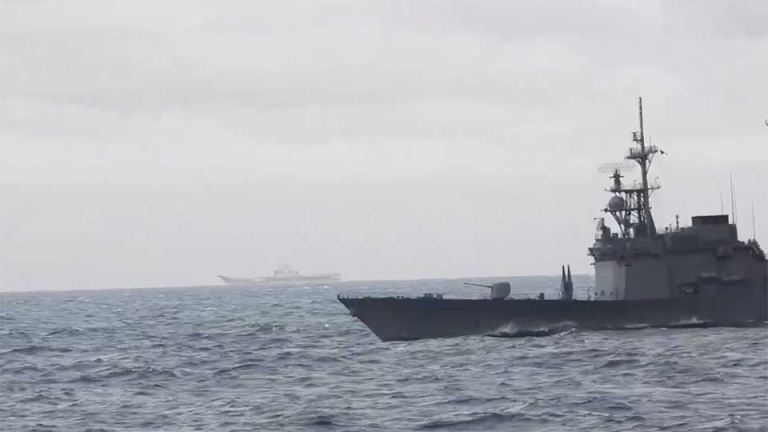Japan’s Self-Defense Forces (SDF) have quietly stepped up their activities in the waters and skies near Taiwan, conducting special military exercises meant to show China how Japan could respond in a crisis. These drills are not routine — they are designed to send a clear message without firing a single shot.
Self-Defense Forces Send a Strong Message Through Drills Near Taiwan
The recent operation involved the Maritime Self-Defense Force (MSDF) destroyer Sawagiri and the minesweeper tender Uraga. On October 3, the two ships carried out a mine warfare drill in international waters south of Okinawa’s Sakishima Islands, an area close to Taiwan. This was the first time Japan had held mine-related training in that region.
A mine warfare drill usually involves placing and retrieving naval mines — underwater explosives that can block enemy ships or control sea lanes. But this time, Japan’s goal was not to test weapons or improve battle readiness. Instead, the Self-Defense Forces practiced only the procedures leading up to mine deployment, such as setting distances and coordination among crews. The exercise lasted just one day, a symbolic move meant to show China Japan’s ability to act if tensions rise around Taiwan.
Sanae Takaichi’s leadership faces early test as China challenges Japan’s new direction
Officials described the drill as part of “flexible deterrent options,” or FDOs — actions meant to deter an opponent by demonstrating readiness and strength. These activities are designed to lower the risk of actual conflict by showing that Japan can respond swiftly to any aggressive move.
Self-Defense Forces Expand Strategy and Locations to Deter Escalation
Until recently, Japan held its mine warfare training in safer areas like Mutsu Bay in northern Japan or the Hyuganada Sea off Kyushu. But in October, Japan made a major shift by conducting the exercise close to Taiwan, one of the world’s most sensitive flashpoints.
Japan’s defense planners spent months preparing for this decision. They identified the area as strategically vital because, in a Taiwan-related crisis, Japan could use it as a chokepoint to control sea routes. If needed, the Self-Defense Forces could lay mines there to block Chinese naval movements.
The timing of Japan’s drills also matched major Chinese military activity. In June, China deployed both of its aircraft carriers — the Liaoning and the Shandong — into the Pacific near Japan for the first time. In response, Japan’s Air Self-Defense Force sent F-2 and F-15 fighter jets to the same area within Japan’s exclusive economic zone near the Senkaku Islands. These aircraft, capable of carrying anti-ship missiles, practiced simulated attacks on vessels.
India joins Malabar naval drill with US Japan and Australia in Guam as tariff issues continue
Japan carried out these operations in airspace that Chinese radar systems closely monitored — a deliberate move to ensure Beijing noticed Japan’s actions. Officials in the Defense Ministry carefully discussed when and where to conduct the operations to deliver a clear “counter-message” without escalating tensions.
Japan’s navy has also stepped up activity in the Taiwan Strait. After a Chinese aircraft violated Japanese airspace last year, an MSDF destroyer made its first-ever passage through the strait, followed by solo transits in February and June this year.
How Japan Uses “Flexible Deterrent Options”
The concept of Flexible Deterrent Options (FDO) originated in the United States and focuses on showing strength and determination before a conflict begins. A well-known example was during the 1996 Taiwan Strait crisis when the U.S. sent two aircraft carriers near Taiwan to deter China from escalating tensions.
Japan began adopting FDO in 2015 as part of its defense cooperation with the U.S. Japan later included it in the National Defense Program Guidelines in 2018 and highlighted it again in the National Defense Strategy of 2022. The aim is to show Japan’s readiness to prevent any attempt to alter the regional balance by force or coercion.
Under this approach, even a routine Self-Defense Forces exercise can send a strong message if carried out at the right time and place. The sight of Japanese ships and aircraft near Taiwan or Okinawa serves as a visible reminder of Japan’s capabilities.
Japan’s giant warship heads to US for deadly Tomahawk missile upgrade
However, such actions come with risks. Operating close to Chinese waters increases the possibility of accidents or misunderstandings that could escalate quickly. To avoid this, Japan’s Defense Ministry consults with the National Security Secretariat and the Foreign Ministry before launching any mission, carefully balancing military intent with diplomatic impact.
Despite these risks, the Self-Defense Forces believe that well-planned exercises strengthen deterrence and promote regional stability. Over the past decade, flexible deterrence has become a key principle guiding Japan’s military planning and coordination with allies such as the United States, Australia, and New Zealand.

